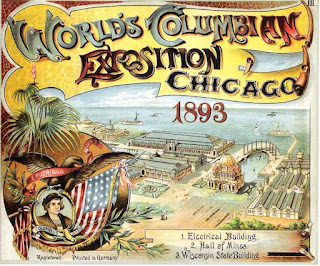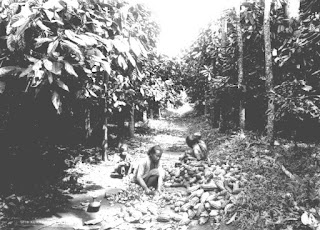CHOCOLATE IN MODERN TIMES: CONSUMPTION
Technological innovations in chocolate production during the Industrial Revolution increased supply and created diversification leading to an explosive growth in chocolate consumption. As consumption spread to the industrial working class, chocolate moved away from its distinctive role as a tasty luxury for the elite and began to assume a new social identity as a treat for the masses. More chocolate and consumers meant a rise in competition among manufacturers to capture market share. Chocolate companies sought advertising vehicles to separate their brand from the competition, drive sales, and attach to chocolate’s new social identity. The nineteenth-century World’s Fairs spotlighted technological advances—a natural coupling for branding chocolate, the “new” food available to the masses as a result of technology. Chocolate manufacturers used the World’s Fairs of the nineteenth and early twentieth century as an advertising and marketing strategy for branding and globalizing the new social identity of chocolate.
World’s Fairs, a popular marketing tool, were themed to mirror society. Over the six-week to six-month duration of each fair individual chocolate manufacturers employed spectacle, technology demonstrations, and sampling to showcase their brand. The three marketing techniques built on each other to layer impressions of chocolate’s new image as an accessible, affordable snack.
Chocolate companies built conspicuous physical spectacles as a strategy to imprint their brand and set themselves apart from the competition. Each company constructed its own pavilion—the more elaborate and expensive, the bigger the impression it made. For example, at the 1876 Centennial Exposition, Maillard’s Chocolate earned a gold medal for its fifteen-foot sugar-and-chocolate sculpted monument depicting episodes in American history. Maillard followed in 1889 with an even larger spectacle at Exposition Universelle: a three-thousand pound reproduction of the Venus de Milo. French critics were not impressed, visitors nibbled at her, and the chocolate Venus began to melt in the heat, but the foibles merely attracted more global press attention for the Maillard brand. Van Houten & Zoon recreated the “Dutch House,” a 1591 town hall in Netherlands to use as their exhibition hall at the 1893 Chicago World’s Fair. Inside, Van Houten advertised their brand and had costumed girls serve hot cocoa. The medal-winning Dutch High Renaissance spectacle was so impressive that a fair visitor had it dismantled and moved to Massachusetts where it still stands, earning a spot on the National Register of Historic Places. Spectacles embedded lasting impressions, but they weren’t chocolate’s only selling point at the fairs.
Manufacturing demonstrations at the fairs gave visitors a start-to-finish experience of chocolate production, a strategy designed to create transparency and instill brand confidence. Walter Baker’s exhibition at the 1904 World’s Fair used German-made miniature machines to demonstrate the steps in transforming raw cacao beans into chocolate powder. Baker included in the display raw chocolate-making materials in glass jars, erasing for visitors any mystery behind Baker’s product. At the 1893 Columbian Exposition, J. M. Lehmann’s exhibit of milk chocolate production on German-made machines may have made the biggest World’s Fair contribution to the globalization of chocolate. Thirty-six-year-old Milton Hershey was so impressed with Baker’s process and display that he bought the machines, had them shipped to Pennsylvania, and used the technology to kick-start a global chocolate empire.
Chocolate’s cheapest and most convincing advertising and marketing strategy at the fairs was its taste. Each chocolate company offered free chocolate or cocoa samples to visitors inside their pavilions, teasing the culinary senses with a taste of the “exotic” while adding marketing extras to promote their brand. At the 1893 Expo, the Baker Chocolate Company served chocolate and cocoa samples accompanied by a free chocolate cookbook of recipes for visitors to reproduce at home. The Blooker Cocoa Company tied spectacle, technology, and sampling together for maximum impact at the 1893 Expo. Blooker reproduced the company’s “cocoa wind mill” on site to ground the cocoa used in the free chocolate drinks served by girls in national costumes of the Netherlands.
World’s Fairs constituted mega-events and media events that globalized chocolate’s new social image through word of mouth and newspaper coverage. Millions of fair visitors included consumers along with chocolate merchants and small-shop distributors, all who carried chocolate’s image and branding down to the local level. Newspapers provided free publicity with photographs and articles about chocolate company marketing spectacles. Individual chocolate companies could never afford to advertise market to market, country by country, and accomplish the amount of reach fairs drew. Because the fairs attracted crowds of around twenty-seven to forty-eight million visitors in addition to free global press coverage, the large sums of money chocolate companies invested in spectacles, technology demonstrations, and product giveaways provided cost-efficient marketing with an expanisive reach.
Chocolate manufacturers successfully used the World’s Fairs from the last quarter of the nineteenth century into the early twentieth century as an advertising and marketing strategy to brand and globalize the new social identity of chocolate. The “golden age” of expositions helped rebrand chocolate in the grandest manner. As the twentieth century progressed, chocolate advertising shifted gear toward direct consumer branding through mass print, radio, and television advertising.
Bibliography:
HIS429. Lecture 7. Chocolate in Modern Times: Consumption
Westbrook, Nicolas. “Chocolate at the World’s Fairs, 1851–1964.” In Chocolate, 199–208. Hoboken, NJ, USA: John Wiley & Sons, Inc, 2009.



Comments